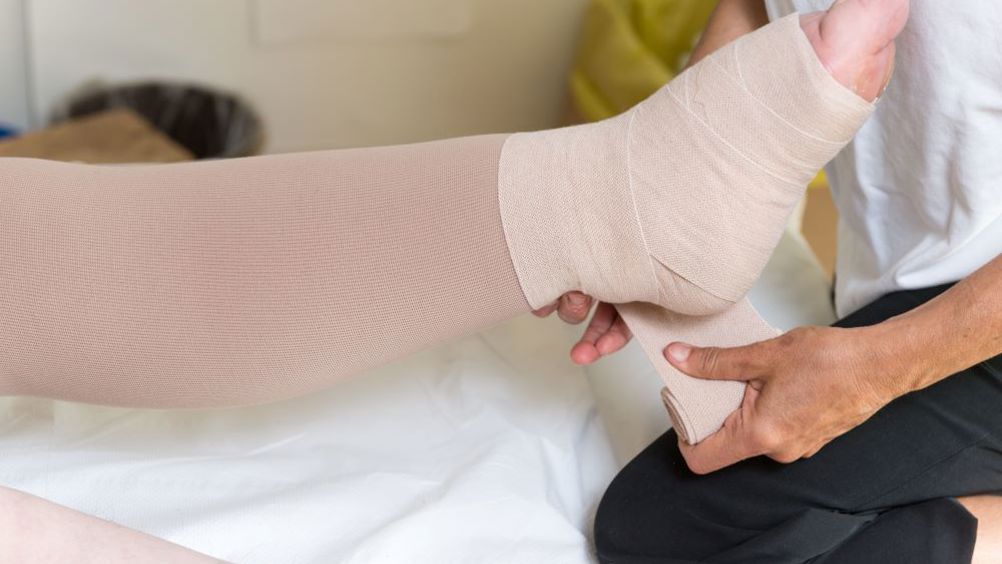Lymphoedema causes swelling in the tissue of any part of the body over a period of time, worsening as time goes on unless managed well. Maclellan and Greene (2022) describe the swelling of the body tissue to consist of a protein-rich fluid, which can be mostly caused by developmental disruption of the lymphatic system, known as primary lymphoedema, or acquired disruption to the lymphatic system, known as secondary oedema.
The extremities are usually most affected (e.g. the feet, related to acquired vascular problems, or hands/arms related to breast cancer), followed by the genitalia. Maclellan and Greene (2022) describe most cases to be secondary to nematode infection, a condition known as filariasis, or to malignancy or cancer treatment. For example, in a breast cancer patient, the lymph node of the affected side is often removed, therefore disrupting the lymphatic drainage in that part of the body, resulting in swelling of the arm. Usually there is one-sided limb swelling in lymphoedema, though this is painless in most patients. The early stages of the disease are characterized by pitting oedema, whereas in advanced disease, there is likely to be non-pitting oedema. A diagnosis is made on clinical grounds but also confirmed using a scan of the lymphatic system known as a lymphoscintigraphy (Maclellan and Greene, 2022).
Lymphoedema is common as it can be secondary to various conditions. It is therefore important to know how to approach the patient's condition – ensuring that they have met and been reviewed by a specialist and that tissue viability nurses are aware of the patient. It is also important to know whether the patient or the nurse needs to apply compression garments, and which day the patient should be receiving their bandaging changes and by whom, and if they require this. It is important to know that a patient has the right garments and items, and to ensure their continuous care under a community nursing team so they do not end up back in the hospital due to a lack of appropriate follow-up and treatment.
The condition has no cure and it is managed over the course of the patient's lifetime using a collaborative approach between the patient and caregivers in the community. There should be a seamless flow of care to prevent further complications with conditions such as injury caused by inappropriate compression or lack of supplies, or an infected leg ulcer left unattended for too long under compression bandaging.
Compression
The first-line of treatment involves using compression of some kind. This may be compression hosiery (which the patient must be appropriately measured for), to complex massage (a drainage technique performed by a specialist – usually a tissue viability nurse), compression bandaging and pneumatic compression devices (Maclellan and Greene, 2022).
Nadal et al (2021) reviewed the use of compression garments in a conventional lymphoedema prevention programme for breast cancer patients who had recently undergone lymph node dissection and were therefore at risk of secondary lymphoedema. The authors note that to prevent the secondary occurrence of this condition in such a patient, there would usually be a lymphoedema prevention programme in place that provides the patient with education on the subject along with exercises to be carried out.
The authors performed a randomised controlled trial which has a small sample size of 70 patients; 35 being the control group receiving the normal prevention programme and the other 35 receiving the compression garment in addition to this. The education was for one hour and exercises were over a 12-week programme. The patients in the group wearing the garment had to wear it for eight hours a day for the first three months post-surgery and two hours a day thereafter. They concluded that after the two years, there was a significant difference between the two groups, with lymphoedema having occurred less often in the group applying the garment. The authors concluded that there should be more research in this area of prevention, and that exercise and education were key factors, but with some efficacy shown in the current use of compression in the treatment of, and in the prevention of lymphoedema (in this case, for breast cancer patients having undergone lymph node dissection).
Moseley et al (2007) describe compression to benefit the patient's presentation by reducing the buildup of interstitial fluid, and preventing lymphatic reflux, while also helping the muscle beneath the fluid buildup by providing an ‘inelastic’ barrier.
The charity, Macmillan, is well known for its work with people living with cancer. However, their information on lymphoedema can be applied to most patients with the condition whether it has been caused by cancer or not. Macmillan (2021) discuss the range of compression garments that, for example, someone with lymphoedema may require. These include: sleeves for swollen arms, stockings for swollen legs, specialist garments for fingers or toes, a compression bra or vest, and specialist garments for the genital area. The tissue viability nurse can give further advice on what is required and how these can be applied. The specialist can train a nurse to apply the garments for the specific patient being reviewed. It is a multidisciplinary team effort to manage the condition.
Patient support
If the condition is not managed well, the patient may feel despondent and develop issues with anxiety or depression, caused by issues such as chronic pain, mobility, and appearance issues associated with lymphoedema, plus their worry about the management itself – it is important they are given the right contacts and information, and the assurance they are receiving the optimal team effort. An offer for mental health support through the relevant service may be a good idea, offered in a way which reflects the sensitive nature of the patient's presentation and the context of the care setting they are in. Privacy must also be considered and it must be remembered that deterioration in mental health can present in various ways or be very subtle.


